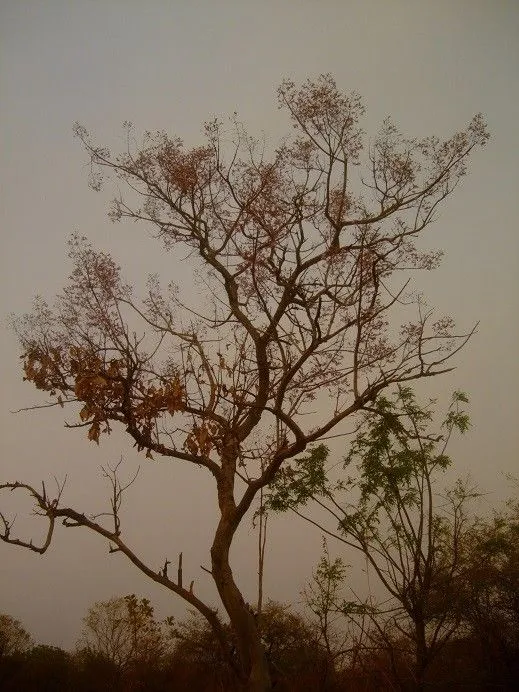
Author: Cham.
Bibliography: Linnaea 7: 720 (1833)
Year: 1833
Status: accepted
Rank: species
Genus: Stereospermum
Vegetable: False
Observations: Trop. Africa
Stereospermum kunthianum, commonly referred to as Nhacavunguti, is a noteworthy species belonging to the Bignoniaceae family, a diverse family known for its vibrant and often tubular flowers. Authored by Cham. and first detailed in “Linnaea,” a reputable botanical journal, in the year 1833, this plant remains significant in both its native habitat and beyond.
Nhacavunguti is predominantly found across tropical regions of Africa, where it thrives in a variety of ecological settings. These regions provide the ideal climate and soil conditions that allow this species to flourish. The plant is appreciated for its resilience and adaptability, often growing in areas where other species might struggle.
Stereospermum kunthianum is distinguished by its often tall, tree-like structure, and the profusion of beautiful, trumpet-shaped flowers that emerge during its blooming season. These flowers are usually a striking feature, attracting not only human admirers but also a variety of pollinators essential for the ecosystem.
The leaves of Nhacavunguti are typically broad, contributing to the overall lush appearance of the plant. This feature, along with its sturdy wood, plays a significant role in local ecosystems, providing shelter and sustenance to a wide array of wildlife.
Culturally and medicinally, Stereospermum kunthianum is treasured in various African communities. Its wood is often used in local craftsmanship, while other parts of the plant are employed in traditional medicine, illustrating the plant’s versatility and importance. The bark, for instance, is used in remedies that address a variety of ailments, showcasing the practical applications derived from this species.
In summary, Stereospermum kunthianum (Nhacavunguti) is a vital component of the tropical African flora. Its biological and ecological contributions, coupled with its cultural significance, make it a species worthy of attention and conservation efforts. Understanding and preserving such plants not only supports biodiversity but also sustains the cultural heritage and traditional practices that depend on them.
En: Nhacavunguti, Pink jacaranda
Af: Pienkjakaranda
Sn: Kabvevesango, Mutandangozi
Wo: Peex
© copyright of the Board of Trustees of the Royal Botanic Gardens, Kew.
© copyright of the Board of Trustees of the Royal Botanic Gardens, Kew.
Taken Mar 20, 2014 by Tela Botanica − Samantha BAZAN (cc-by-sa)
Taken Mar 20, 2014 by Tela Botanica − Samantha BAZAN (cc-by-sa)
Taken Jan 12, 2011 by Tela Botanica − Florian FRAIX-BAVUZ (cc-by-sa)
Taken Jun 19, 2022 by Magnun Paula Pereira (cc-by-sa)
Taken Jun 19, 2022 by Magnun Paula Pereira (cc-by-sa)
Taken Jan 12, 2011 by Tela Botanica − Florian FRAIX-BAVUZ (cc-by-sa)
Taken Jun 19, 2022 by Magnun Paula Pereira (cc-by-sa)
Taken Jan 12, 2011 by Tela Botanica − Florian FRAIX-BAVUZ (cc-by-sa)
Family: Myrtaceae Author: (F.Muell.) K.D.Hill & L.A.S.Johnson Bibliography: Telopea 6: 402 (1995) Year: 1995 Status:…
Family: Rubiaceae Author: Pierre ex A.Froehner Bibliography: Notizbl. Bot. Gart. Berlin-Dahlem 1: 237 (1897) Year:…
Family: Sapindaceae Author: Koidz. Bibliography: J. Coll. Sci. Imp. Univ. Tokyo 32(1): 38 (1911) Year:…
Family: Asteraceae Author: A.Gray Bibliography: Pacif. Railr. Rep.: 107 (1857) Year: 1857 Status: accepted Rank:…
Family: Fabaceae Author: Medik. Bibliography: Vorles. Churpfälz. Phys.-Ökon. Ges. 2: 398 (1787) Year: 1787 Status:…
Family: Aspleniaceae Author: (Cav.) Alston Bibliography: Bull. Misc. Inform. Kew 1932: 309 (1932) Year: 1932…